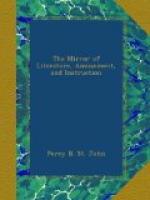Physicians, in visiting the sick, have been known to form a prognostic, before having seen the patient, from the effluvia of the sick-room. Those who are in the habit of visiting the insane, know the peculiar odour that characterises that dire calamity; and it was remarked of the plague, that it had “a scent of the flavour of mellow apples.”
It is said that monkeys possess this power of discrimination in a very eminent degree. A story is told of a lady who had a pet of this description, whom she made her constant companion, and who suddenly, without any apparent cause, forsook her, and could not be persuaded to re-enter her chamber. The lady was at that time infected with measles, which shortly after appeared upon her; but, on her perfect recovery, the monkey returned to her with his usual familiarity. Some time after, the same lady caught cold, and was apparently very ill, but without fever. The monkey, as far as might be judged from his appearance, seemed to condole with his sick mistress, and to understand the difference of her distempers, by the confidence with which he remained in attendance upon her.
It has even been said, that the sagacity of some dogs has led them to prognosticate the fatal termination of disease. “Whilst I lived at Ripon,” says a learned doctor, “I took notice of a little dog, of a chestnut colour, that very often boded the death of sick persons, without being once, for aught I could learn, mistaken. Every time he barked in the night under the windows of any one whose sickness did not even appear dangerous, it happened, infallibly, that the sick person died that week. I knew also,” observes the same author, “a man bit by a mad dog, who could distinguish his friends at a considerable distance by the smell, before even he could distinguish them by sight.”
So early as the second century, the supplying the deficiency of a lost nose became an object of professional consideration; and the Greeks gave the name [Greek: Kolobhomata], to those who required such an operation. Taliacotius was the first who treated it scientifically; and, from his time, the art of Addition became one of the branches of surgery; and, under the title "De Decoratione," formed a very interesting chapter.
Although Taliacotius has the credit of bringing the art of nose-making into fashion, and being the first to write on the mode and manner of performing the operation, yet it appears that one Branca had been in the habit of performing it long before, as we learn from an ancient author, whose name must, in this instance, be considered as the highest authority, being no less a person than NOSORENUS.
Why the magistracy of Bologna should have conferred the high honour of a statue on Taliacotius it is difficult to understand,—unless the loss of the nose was of more frequent occurrence than in those days, from the barbarity of warfare and civil punishment; for an old law of the Lombards assigned the loss of the nose as a punishment for theft; and the captives in war were equally spoiled for snuff-takers.




